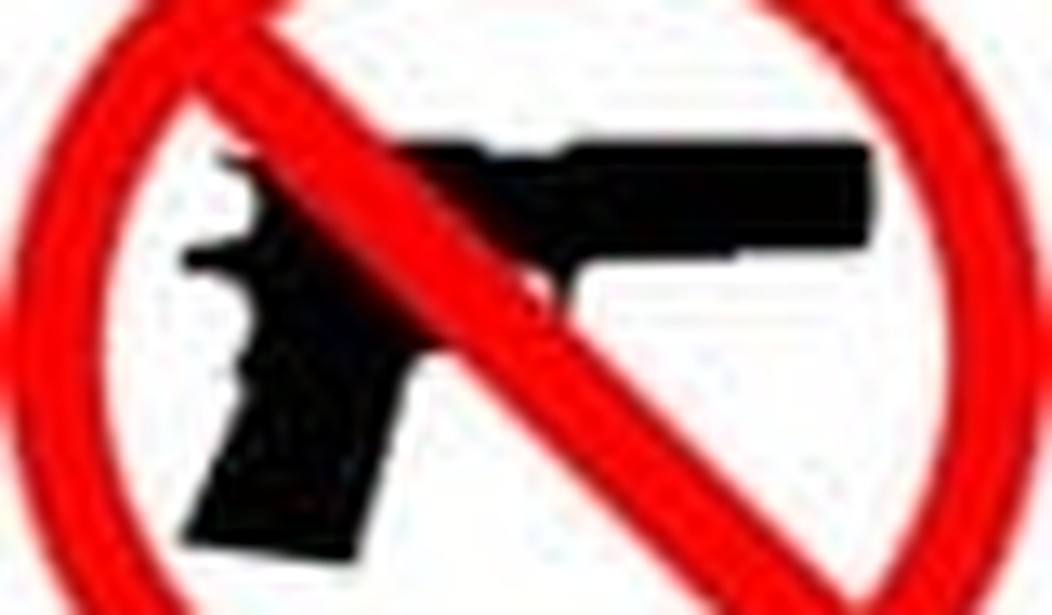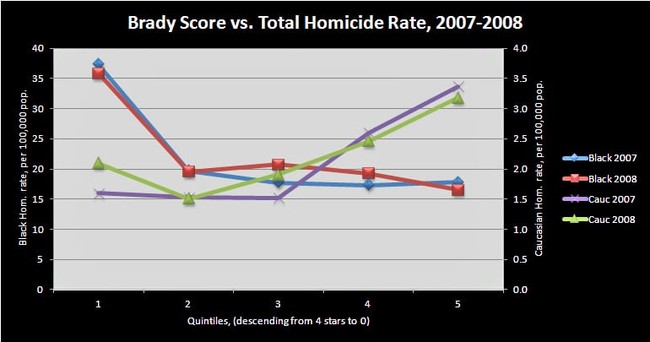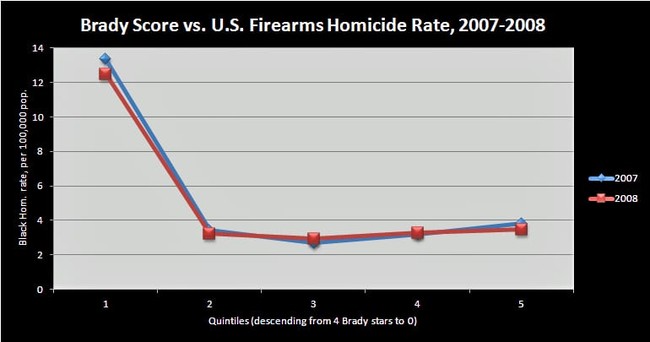Recall: the Brady Campaign to Prevent Gun Violence endorsed Barack Obama as president, and celebrated the 2008 elections as a victory for gun control:
The 2008 elections demonstrated … that voters support candidates who favor strong gun laws and reject the gun lobby’s extremist agenda.
In February 2009, Obama’s Attorney General Eric Holder announced the administration wanted to make “a few gun-related changes” including a ban on “assault weapons.”
This year began with great promise for the Brady Campaign. After Gabrielle Giffords was shot, Brady President Paul Helmke announced:
[W]e can and should do more … to address the easy access to high-powered guns that make it too easy for dangerous and irresponsible people to disrupt and destroy the lives of innocent Americans.
Implying the Brady campaign was pleased by the Giffords shooting is of course incorrect, but after the fact, gun-control proponents have exploited shootings of public officials for their cause. For example, the Brady Campaign is named after Jim Brady, President Reagan’s press secretary who was shot during an assassination attempt. The Brady Campaign had reason to hope history would repeat itself — but Congress didn’t respond.
Instead, Brady leaders had to rely on Obama’s promise during a private meeting that he was working on gun control “under the radar.” Not long after, the Fast and Furious scandal blew up in the administration’s face.
Nevertheless, last June, Brady Vice President Dennis Henigan misrepresented ATF data by declaring that 70% of all Mexican cartel guns came from U.S. gun stores. He did not mention that that most came from ATF, FBI, and DEA smuggling, U.S. State Department sales to Central American countries, and the black market.
While Congress deposed him regarding Fast and Furious, Holder accused congressional investigators of revenge and racism. Yet Brady’s own data prove this statement an example of Brady’s hypocrisy and lack of credibility. States with the most gun control have the lowest levels of gun ownership. They also experience the highest black homicide and lowest Caucasian homicide rates.
In 2007, Brady began publishing an annual scorecard grading states’ gun control laws on a 100 point scale, then assigning “stars” to states: four stars was Brady’s best (most gun control), no stars their worst, with the assumption that Brady’s “best” states were the safest. State grades were then collated with the latest available (2008) homicide data from the Centers for Disease Control. The graph below shows that while Brady’s “best” states were safest for Caucasians, they were the deadliest for blacks (the black homicide rate scale is on the left, the Caucasian scale is on the right):
(For statisticians: Spearman’s coefficients for 2007 are black 0.70, Caucasian -0.60; for 2008, black 0.90, Caucasian -0.70. As Brady scores dropped — less gun control — so did black homicide rates, while Caucasian rates increased.)
This is important, because American gun control is rooted in racism — it was originally designed to protect white European immigrants from Native Americans. After the Revolution, gun control protected white Americans from black slaves and freemen, and then helped our government imprison Japanese Americans in World War II.
Worse for Brady, their “safest” states had the highest black firearms homicide rates, but the lowest Caucasian rates:
(Spearman’s coefficients for 2007 are black 0.90, Caucasian -0.60; for 2008, black 0.90, Caucasian -0.90. Again, less gun control correlated with lower black firearm homicide rates, while Caucasian rates increased.)
Examining the total U.S. firearms homicide rates, Brady’s thesis that gun control reduces “gun violence” appears dubious:
(Spearman’s coefficient for 2007 is 0.30; for 2008 it is 0.10. Less gun control weakly correlated with lower firearms homicide rates.)
More bad news for Brady: Collating their scorecards with FBI violent crime shows that right-to-carry (RTC) states — where law-abiding citizens have broader rights to carry a concealed handgun — are becoming safer over time, compared to Brady’s “safest” states, which don’t give citizens such rights. (The graph below displays states’ average violent crime rates by RTC status, with the percentage difference in green.) As of 2010, RTC states were 35.0% safer than non-RTC states, and had a 41.9% lower murder rate, too:
Brady gave RTC states an average scorecard value of 9.0 in 2010, while non-RTC states averaged 51.3. According to Brady, non-RTC states are safer because they enforce more gun control laws such as firearm registration, waiting periods of up to 10 days before you can pick up the gun you already bought, and bans on magazines containing over 10 rounds of ammunition. In Brady’s imaginary world, the above violent crime values would be reversed.
Savvy analysts will rightfully note the above correlations aren’t necessarily significant, and that’s the point: Brady claims that guns cause violence, yet they are unable to cite one comprehensive, significant dataset to corroborate their claims. Instead, they select factoids to support their propaganda, all rendered invalid upon examining the entire source data.
This is why the Brady Campaign is losing credibility, influence, and revenues. By the end of 2009 — the latest year for which data are publicly available — Brady’s total net assets were negative $564,123. Between 2006 and 2009, Brady’s total revenues dropped from $4,636,210 to $4,004,014, including investment income and royalties.
Brady began listing membership income as a separate line item in 2009. Mailing list company Consumerbase sells a Brady list currently containing 123,562 names, and reports that the average donation is $40. Collating these numbers with Brady’s tax return indicates they have about 32,000 members, plus 68,000 other contributors. (These numbers include the Million Mom March, which is now part of the Brady Campaign.)
By comparison, the Texas State Rifle Association has 40,000 members, and the National Rifle Association has “nearly four million members.”
Meanwhile, the Second Amendment continued experiencing a gradual recovery across America, as can be seen in the following examples:
- Wisconsin became shall-issue concealed carry, after completely banning legal carry for many years. (Qualified law-abiding residents who apply must be issued a license to carry a concealed handgun.) Within six weeks of the law’s November 1 effective date, the Wisconsin Department of Justice received 56,000 permit applications, with “fewer than two dozen” being rejected because of criminal or mental health history. Another article notes: “It appears gun sales are on the increase.”
- Wyoming became the fourth state to pass Second Amendment concealed carry (no license necessary).
- Iowa moved from a sheriff-discretionary licensing system to shall-issue on January 1. The number of Iowans seeking carry permits has increased 170 percent (nearly tripled).
- Paul Valone of Grass Roots North Carolina says: “Our new Castle Doctrine law allows victims to use deadly force in cases of forceful and unlawful entry into a home, vehicle or workplace. The law also removes victims’ duty to retreat prior to using deadly force, and extends concealed carry into state and municipal parks.”
Local stories indicate the sea change that rarely garners national attention:
- In Wisconsin, a group of men openly carrying guns last year accepted a settlement over their civil rights lawsuit with the city of Madison. The Madison Police Department chose to arrest these men, despite Wisconsin’s longstanding open carry law, but then dropped all charges and changed their policy.
- The Wichita, Kansas city council voted to allow guns in 111 city buildings.
Founder James Madison wrote:
Besides the advantage of being armed, which the Americans possess over the people of almost every other nation, the existence of subordinate governments, to which the people are attached, and by which the militia officers are appointed, forms a barrier against the enterprises of ambition, more insurmountable than any which a simple government of any form can admit of.
For 2012, the most important criteria in determining a candidate’s legitimacy: how comfortable is the candidate with the concept of armed citizens?













Join the conversation as a VIP Member